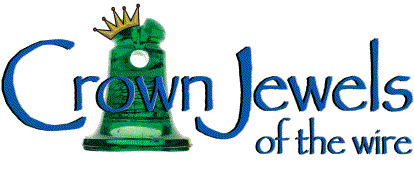World Class Insulators (Continued)
By Howard Banks
Reprinted from "Crown Jewels of the Wire", May 2003, page 30
In this issue of Crown Jewels we are pleased to present a second series of
colored pictures of world class CD 151 insulators. These are among the best
examples of that style known to the hobby. (See the May issue of Crown Jewels
for part one.)
If I can get the page numbers correct this month, the insulator at the top of
page 31 is our cover girl. She's a beauty with a remarkable deep purple swirl in
the dome. With the sharp drip points many of these 151's have on both the outer
and inner skirts, I'm always amazed they survived telegraph and railroad
environments without more damage to their girlish figures. At the bottom of page
31 is a two tone green, smooth based, example with colorful swirls.
Page 32 (top) features a smooth base 151 in depression glass green. And at
the bottom, the one and only amber HG CO CD 151 ever found. Last month we
pictured a red amber "no name" (unembossed) example that had been dug
in the dump of a glass factory. The amber H G Co shown this month was found in
use. In fact, a collector reportedly observed the unusually dark colored
insulator on a line for a long time before stopping to check it out. There's
some inner skirt damage, but who can complain when the insulator is one of a
kind.
Page 33 (top) depicts a peacock blue N.A.T.Co. But this one is different. If
the picture looks "fuzzy", it's because the insulator is full of milk.
If the basic color of the insulator was green, we'd call the resulting color
"jade". So maybe we should describe this one as jade peacock? Or jade
milk peacock? How about... just calling it pretty. At the bottom of page 33 is a
silver colored 151 with purple swirls.
On page 34 are two more smooth based 151 's. At the top is another nice green
swirled example. Just because we've shown several green 151's, please don't
think they are common. It's not at all unusual for dramatic green examples to
sell for $7,000 each or more! At the bottom of page 34 is a choice dark
cornflower blue 151. These are much more common, but every bit as beautiful.


In case the May and June color inserts have inspired you to collect CD
151's, here's some useful information to help you get started. 151's were
manufactured by Brookfield, HG Co (Hemingray), and (likely) King City Glass
Works. Additional "no name" varieties are found.
John and Carol McDougald's Insulator Price Guide lists three embossing
varieties in 151's made by Brookfield. HG Co examples are found in at least 18
mold styles (including smooth based examples, those with drip points on both the
inner and outer skirts, drip points on only the outer skirt, and various
embossing configurations.) Three different markings are found on the "no
name" specimens, and some 151's can be found with no embossing whatsoever.
But it is the HG Co specimens that are the most widely collected. The is
probably due to the wide variety of colors found in H G Co units. Here's a list
of HG Co CD 151 colors named in the Price Guide: Aqua, light aqua, ice aqua, ice
blue, blue aqua, light blue, light steel blue, green tint (off clear), smoke,
Hemingray blue, light cornflower blue, purple tint, cornflower blue, dark
cornflower blue, apple green, clear, depression glass green, green, teal blue,
sapphire blue, jade green milk, forest green, olive green, dark yellow green,
yellow olive green, orange brown amber, purple, peacock blue, electric blue,
light electric blue, cobalt blue, dark peacock blue, dark electric blue, milky
aqua, lime green, ice aqua with purple swirls, and gray purple. No doubt there
are a whole lot more colors waiting to be described, such as the "peacock
blue jade milk" shown on page 33. Add in amber swirls, bubbles and
junk-in-glass and the 151's can become a specialty with no end in sight.
If you were to collect 151's produced by all manufacturers, you could add
emerald green, celery green and root beer amber to your insulator rainbow.
The CD 151's shown in the May and June issues of Crown Jewels are owned by
Tim Wood of Oregon and Tommy Bolack of New Mexico. Photographs are by Carol
McDougald.
|
